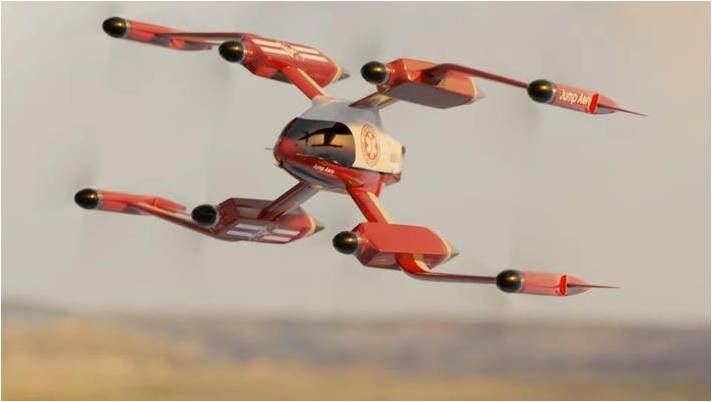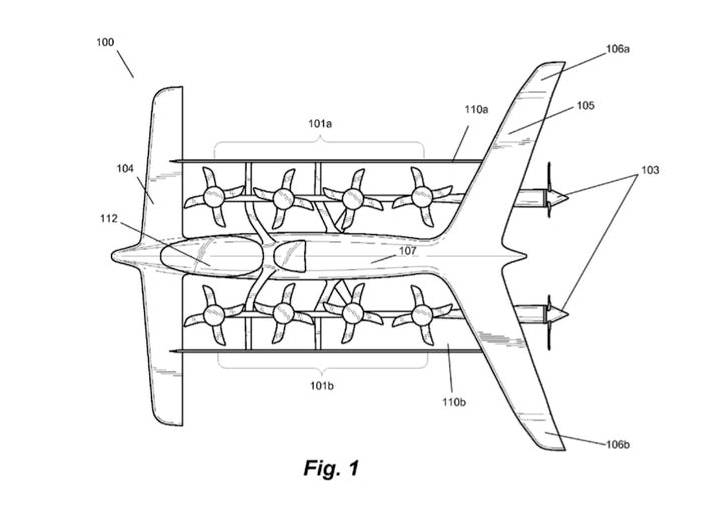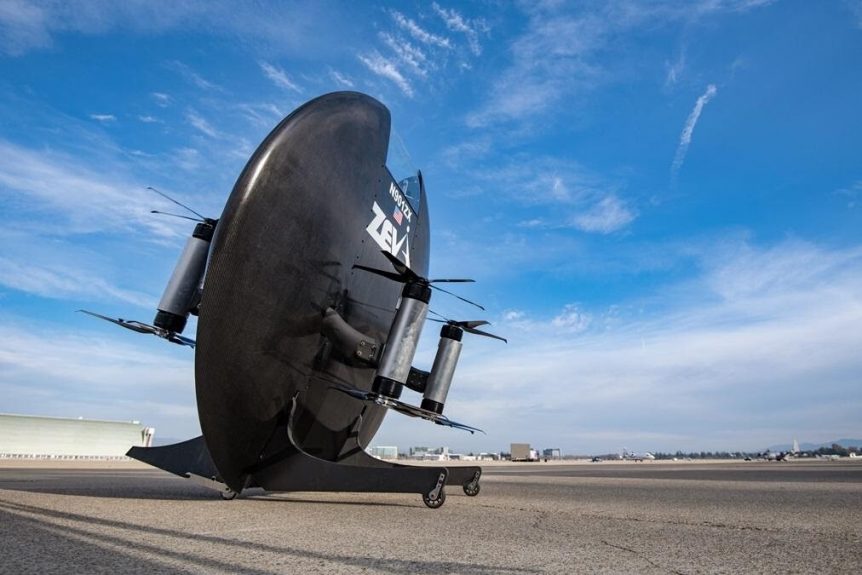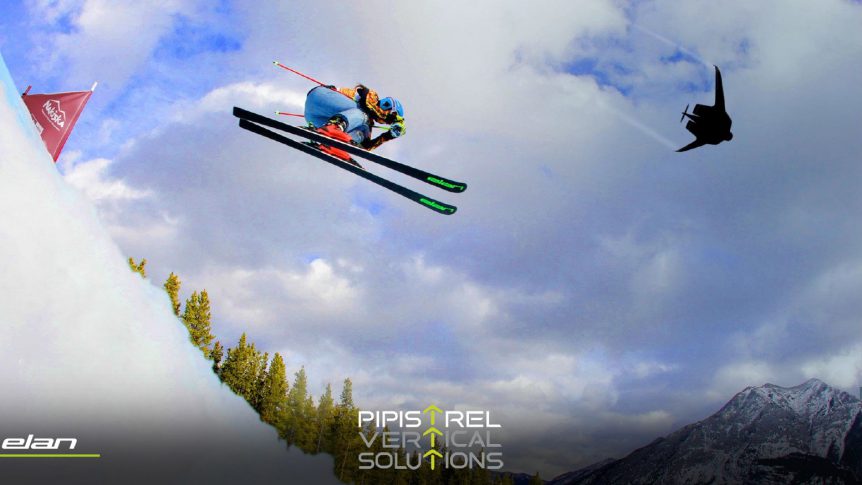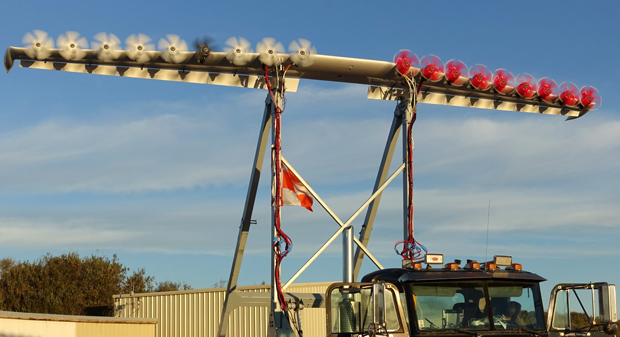Jump to the Rescue The State of Oregon might be ready to Jump into serving remote areas with a startling type of drop-in emergency vehicle. Jump Aero’s Pulse eight-motor biplane configuration could whisk emergency medical technicians on a flight to patients who could otherwise wait for a half-hour or more before help could arrive. Joshua Kupietzky, writing in Simple Flying, cites five characteristics of the craft that merit attention. “Quick arrival times… Serving a special niche… Battery-powered life-saving impact… Vertical takeoff… Easy to use and maintain.” These features describe many eVTOLs (electric Vertical Take Off and Landing) aircraft, but the Pulse allows landing in the space that would otherwise be taken up by an ambulance or small fire vehicle. Carrying a trained professional EMT or firefighter to the scene along with an array of emergency gear, Pulse can have said professional giving medical care or putting out fires within minutes of setting down. Because it’s a tail-sitter, the pilot enters …
Kittyhawk to Close Doors, Open Another
While Eviation’s Alice is drawing adulation for its initial test flight, Kittyhawk, a one-time front-runner and pioneer is quietly closing down. A vision of Larry Page, Sebastian Thrun, and Ilan Kroo, Kittyhawk brought us several approaches to personal green flight, with a heavy emphasis on intuitive control and automated flight. One of its many approaches lives on, though, through sister company Wisk. Blooper Reel Kittyhawk’s earlier efforts look somewhat like an aeronautical blooper reel, one of those montages of early flying machines that evoke laughs when shown as preludes to more serious stuff in movie theaters. Kittyhawk, though, avoided crashes and humiliation. The firm explains its history: “Kittyhawk was founded in 2010 by autonomous car pioneer Sebastian Thrun with the backing of Google co-founder Larry Page to explore the frontier of then-new eVTOL aviation.” From Zee to Kittyhawk Originally founded as Zee Aviation, Kittyhawk was secretive, with only glimpses of its potential aerial vehicles surfacing as “spy shots.” The ZP-1 …
Zeva Zero – the Return of the Puffin?
Dreams of flight often include the dreamer wearing a silk scarf, if not a cape. We would love to emulate our super heroes with all their startling dexterity. A group in the Puget Sound area is making part of that dream come true. Starting with radio-controlled models a few years ago Zeva Aero has progressed to a full-scale unit that will carry an individual Superman style, with the pilot/passenger peering through a transparent shield. Needing only a 30-foot by 30-foot landing area, Zeva’s Zero boasts the ability to hoist a 220-pound person vertically, tilt over and take them 50 miles at up to 150 miles per hour. Zero’s eight electric motors provide a degree of redundancy and safety, enabling flight with a few motors not at their full potential (an electrical pun there). The firm says, “ZERO is a new class of aircraft that blends the best features of multi-copter with streamlined wing-body for improved range and efficiency.” The …
Referencing Uber’s Elevated Challenge
We can tell things are heating up in the electric aircraft marketplace. Established aircraft companies are investing (Boeing and Airbus for starters), growing numbers are planning for electrified and autonomous future flight (Uber Elevate Summit), and an absolute plethora of new designs are tumbling forth from an aeronautical cornucopia. Their video of an Uber sky taxi ride illustrates the charm of the idea. A Common Reference Uber provided two common reference eVTOL (electric vertical takeoff and landing) reference models for partners to emulate. Both seem to share a common passenger pod with an unusually long tail boom. Perhaps taking the 2011 Green Flight Challenge as his reference point, Mark Moore explained how Uber inspires others to give their best efforts to create several plausible vehicles. The American Institute of Aeronautics and Astronautics (AIAA) reports, “’We will never build a vehicle, but we want to make sure that our partners who are building vehicles are successful and that these aircraft are …
Pipistrel’s Tine Tomazic Tours West Coast for eVTOL
Visiting Los Angeles for UBER’s second Annual Elevate Summit on May 8, Tine Tomazic and Igor Perkon presented Pipistrel’s new electric vertical takeoff and landing (eVTOL) concept. As described in their press release, Pipistrel’s new design “utilizes dedicated propulsion systems for both cruising and vertical lift and embraces an aircraft styled family approach of eVTOL able to carry between 2 to 6 passengers.” Mark Moore, UBER’s Director of Engineering, attempted to find out about the “sauce” that helps make Pipistrel’s eVTOL concept unique, but was deflected by Tine’s response that the “airplane” (important distinction) would be a “cruise plus lift” machine, emphasizing speed of transit, but relying on electric power to provide vertical lift. He also noted that propulsion would be distributed. At the Sustainable Aviation Symposium on May 11, Tine did not talk about that matter, but gave an excellent review of Pipistel’s electric and hydrogen-powered aircraft, and the company’s ongoing efforts to achieve “green” aviation. They have been …
2015 PADA Awards Dinner and Presentation
The CAFE Foundation’s announcement should capture our attention. “The 2015 Personal Aircraft Design Academy will feature two excellent presentations: Burt Rutan on the SkiGull and Nick Borer on the LEAPTECH project. This will be followed by the ceremony to award the esteemed PADA Trophy to a surprise recipient. A reservations-only $20 hors d’oeuvre pre-reception at 6:15 PM on July 24 in the EAA Museum’s Fergus Plaza will provide an excellent opportunity to meet with aviation’s top personal aircraft designers. “The Personal Aircraft Design Academy (PADA) gathering for 2015 will begin with a special indoor hors d’oeuvre reception for $20 per person that begins at 6:15 PM on Friday, July 24 in the Fergus Plaza lobby of the EAA Museum. This will be followed by the PADA Program in the EAA Museum’s air-conditioned Vette Theatre at 7:30 PM. “In addition to a presentation by the 2015 PADA Trophy winner, the 2015 PADA program plans detailed presentations by Burt Rutan about his brand new …
EAS IX: Low Aspect Ratio Airplanes – Against the Grain
Barnaby Wainfan is a technical fellow with Northrop-Grumman, but possibly best known for the FMX-4, well known as the “Facetmobile.” His talk on “Low Aspect Ratio Electric Airplanes gave attendees at the ninth annual Electric Aircraft Symposium a great deal of counter-intuitive insights into how a successful airplane can look and work. The FMX-4, he pointed out, is a low-aspect-ratio, light weight, single primary structure, low-parts-count airplane with benign flying qualities. When, as he told his audience, he decided to stop talking and start testing, he began with X-Plane computer simulations to check out his theories and studied simple, fast-building structures that would get him into the air expeditiously. N117W was easier to build than curved sticks, and despite its angular lines, the airflow doesn’t separate over its flat surfaces. He could carry an approach at 10 degrees positive angle of attack (AOA) and still have 30 degrees available before reaching a stalling point. The airplane carries a payload equal …
EAS IX: Mike Ricci Explains PWB, Safety
Dreamliner battery nightmares have troubled the dreams of electric flight for the past two years. Michael Ricci, Vice President of Engineering with LaunchPoint Technologies, gave attendees at this year’s Electric Aircraft Symposium a crash course (pun intended) in the many types of failure modes electric aircraft face. Luckily, he also provided ways to mitigate and eliminate those failure modes. He introduced a concept called “Propulsion by Wire” (PBW), the main thrust for electric aircraft and roughly akin to the commonly discussed “Fly by Wire” concept. Asking what product specifications for electric propulsion will look like, he answered his own rhetorical question with the technical requirements for reasonable interaction, a useful user interface, airworthiness, and safety. Starting with the last issue first, safety (which should always come first), we need to be able to continue safe flight after a single component failure. There are some surprising, counter-intuitive things at work here. Depending on whether we start with a qualitative hazard analysis …
EAS VIII: Joby Motors – on Simple and Complex Airframes
JoeBen Bevirt, founder and CEO of Joby Aviation, Joby Motors, and related enterprises, has thought long and hard about the financial costs and lost productivity brought about by the daily automotive commute, a 1.6 hour per day ordeal for many in our urban centers. JoeBen and the Atlantic magazine agree that commuters squander 5.5 billion hours and 2.9 billion gallons of fuel annually, stuck in the fitful despair of slow or unmoving traffic, sharing only frustration and polluted air with their fellow motorists. JoeBen told attendees at the April Electric Aircraft Symposium that several years before, he had the seeming pipe dream of moving people by air in a single-seat, eight-motorm, vertical takeoff and landing, electric commuter aircraft that would take one 100 miles at 100 miles per hour for one dollar. The combination of Greg Cole’s Sparrowhawk and electric power focused too much on efficiency, according to JoeBen, and battery technology had not evolved to allow the practical outcome …
EAS VIII: High Efficiency Forward Swept Propellers at Low Speed
Working with Craig D. Paxton, Peter J. Gryn, Erisa K Hines, and Ulises Perez, Dr. Ge-Cheng Zha of the University of Miami Department of Aeronautics and a NASA Innovative Advanced Concepts (NIAC) Fellow, has worked on a method to improve propeller efficiency and reduce blade stall using a forward tangential swept configuration. Dr. Zha wowed EAS VII attendees last year with his astonishing high-lift, high-speed wing design. This year, he gave hope for advanced propeller design. The professor and his team are trying to increase general aviation fuel efficiency and reduce pollution. Propellers, imparting the energy from the engine or motor to the air, are a good place to start. Most current propellers are axial and are straight bladed or have blades with a backward sweep, the well-known scimitar blade shape. This approach mimics the advantages gained from swept wings. Zha’s team borrowed from turbofan technology to develop forward tangential swept propellers. They might have looked at sailplanes like the …
- Page 1 of 2
- 1
- 2

